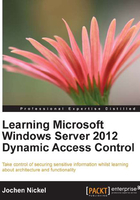
What this book covers
Chapter 1, Getting in Touch with Dynamic Access Control, will cover the business needs, purposes, and benefits of Dynamic Access Control. We will discuss and study the architecture in detail and start by building the test lab and our first simple solution.
Chapter 2, Understanding the Claims-based Access Model, will explain the idea of identities and claims especially in the use of Windows 8 and Windows Server 2012. It will also suggest how Kerberos Armoring and Compound Authentication works and about how to manage claims and resource properties. The test lab will guide you deeper into the functionality of DAC.
Chapter 3, Classification and the File Classification Infrastructure, will review the required information to map the business and security requirements to classify information. We will also explain the different methods to classify information and how the File Classification Infrastructure and the Data Classification Toolkit can support your implementation.
Chapter 4, Access Control in Action, will focus on Central Access Policies. The Central Access Policies are one of the most important components, and we will explain how to define, configure, and manage them with a staging and productive environment. The chapter will also discuss access-denied assistance.
Chapter 5, Auditing a DAC Solution, will cover the usage of conditional expressions and the global object access auditing settings and options that System Center Suite provides you with to build an efficient and comprehensible solution.
Chapter 6, Integrating Rights Management Protection, will discuss the important aspects of the Active Directory Rights Management Services integration in a complete information protection context.
Chapter 7, Extending the DAC Base Solution, will cover methods and tools to get the necessary data quality in Active Directory for using Dynamic Access Control. We will also provide an overview of important third-party tools, SharePoint, and Bring Your Own Device strategy integration.
Chapter 8, Automating the Solution, will cover the automation possibilities such as the Forefront Identity Manager, System Center Suite, and Data Classification Toolkit for Dynamic Access Control. The chapter also gives you an idea of different architectures to fulfill the different requirements in actual projects.
Chapter 9, Troubleshooting, will discuss common problems and how to address them. It gives you a tutorial from the general to the advanced troubleshooting strategies for Dynamic Access Control. The chapter will also offer a collection of external resources such as blogs, wikis, and articles.